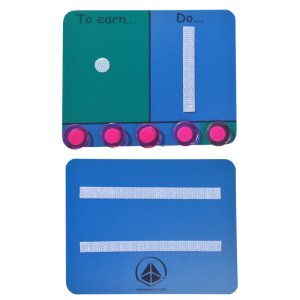By Anne Overcash, M.Ed.


Naturally, for paid employment, compensation is part (perhaps the most important part!) of the contract process. After compensation has been determined, some individuals may continue to benefit from a more concrete representation of deals that are negotiated and honored much more frequently than the pay period. A visual system that provides information such as: “What am I working for? How am I doing? and Where am I in this deal?” can help!
This article focuses on learners who are successful with these types of visual systems. I am not suggesting that these visually based systems replace paid compensation.
The word transition implies the passage of time. A dramatic change in the way a system is presented is not likely to result in a smooth transition. Rather, quite the opposite may occur. Remove or drastically change a currently effective system and you are likely to observe challenging behavior. A more thoughtful and measured approach is the way to go. Determine the goal for each leaner and make gradual changes. In time, these changes will add up to dramatic and important shifts.
The shift from concrete visual representations of deals that include points or tokens delivered by someone else to systems that can be easily and effectively maintained in the world of work will take time. Here are some examples where teams made changes to current systems as they continue to teach skills that will lead to important life outcomes. 
These examples assume the following:
- Learner demonstrates they know how their system works in the following ways:
- As soon as the last point or token is received, they immediately begin to exchange or cash in for the previously agreed upon item or activity
- They do not continue to work once the deal is complete
A little now or more later?
At the end of each deal the learner can either access the current item/activity or bank those to accumulate toward something better. One teacher simply added time to preferred activities. Cash in for 5 minutes gaming time now or bank those minutes and earn 15 minutes for a larger number of points later. It worked brilliantly! Perhaps because engaging with many games may be much more exciting when played for an extended amount of time. Bonus idea: More accumulated points = extras such as choice of comfy gaming chair, gaming partner, preferred controller, the list could go on!
Step into a banking account 
This idea is great for learners who are becoming familiar with various apps for tasks (calculator, planner, etc.), not just using a tablet for entertainment. Assign monetary value to points/tokens. Once each negotiated deal is complete, the monetary value is added into their student bank account. Available reinforcers have a preassigned value. At various points in the day, learners have opportunities to visit the class or school store and purchase. Plan to stretch earn times to fit with naturally occurring break times if they do not align in the beginning. There are simple banking apps used for teaching purposes, some may even have a free or light version. Here’s an “old school” example: In the late 1990s I worked with a middle school team that gave each learner a check book and taught them to credit the amount earned and debit the amount when purchases were made from the class store.
Chocolate pudding, please!
Food example alert! All kidding aside, chocolate pudding is used in this example because this was the most preferred snack for this learner and had been for many years.

In summary, learners are just as diverse as the ways they learn. As such, the types of reinforcement systems used are vastly different. There really is no “one size fits all” approach to helping learners who use visually based systems transition to systems that can realistically be maintained once they enter the world of work. I hope that these scenarios add to your knowledge base as you strive to support individuals during this important transition.
For more information and helpful strategies:
- Post a comment or question on our Facebook group: PECS User Support
- Join us at Pyramid’s FUNctional Behavior Conference 2022 on April 4th & 5th
- Attend a Pyramid Approach to Education Training
- Schedule time with a consultant via remote consulting sessions
- Contact us directly via email: pyramidus@pecs.com
© Pyramid Educational Consultants, LLC. 2022
